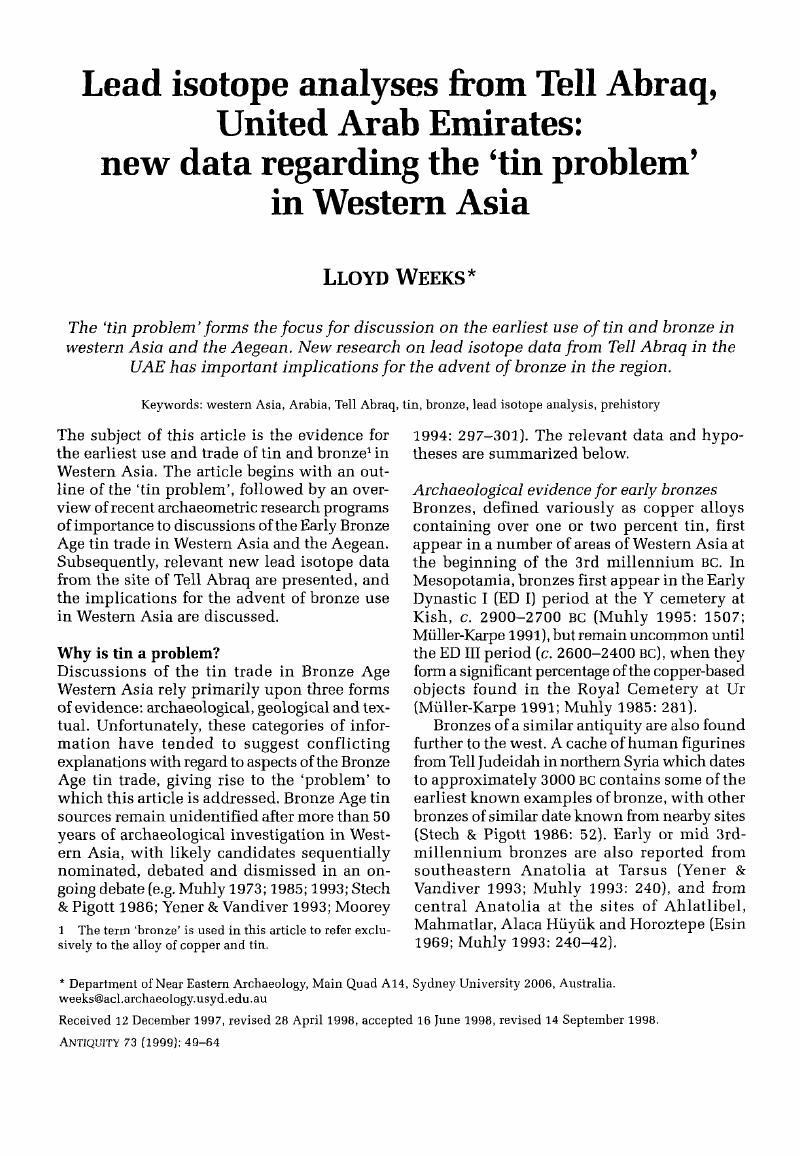Crossref Citations
This article has been cited by the following publications. This list is generated based on data provided by Crossref.
Ratnagar, Shereen
2001.
The Bronze Age.
Current Anthropology,
Vol. 42,
Issue. 3,
p.
351.
Thornton, Christopher P.
Lamberg-Karlovsky, C.C.
Liezers, Martin
and
Young, Suzanne M.M.
2002.
On Pins and Needles: Tracing the Evolution of Copper-base Alloying at Tepe Yahya, Iran, via ICP-MS Analysis of Common-place Items.
Journal of Archaeological Science,
Vol. 29,
Issue. 12,
p.
1451.
Kassianidou, Vasiliki
and
Knapp, A. Bernard
2005.
The Archaeology of Mediterranean Prehistory.
p.
215.
Bobokhyan, A.
2009.
Trading implements in early Troy.
Anatolian Studies,
Vol. 59,
Issue. ,
p.
19.
WEEKS, L.
KEALL, E.
PASHLEY, V.
EVANS, J.
and
STOCK, S.
2009.
LEAD ISOTOPE ANALYSES OF BRONZE AGE COPPER‐BASE ARTEFACTS FROM AL‐MIDAMMAN, YEMEN: TOWARDS THE IDENTIFICATION OF AN INDIGENOUS METAL PRODUCTION AND EXCHANGE SYSTEM IN THE SOUTHERN RED SEA REGION*.
Archaeometry,
Vol. 51,
Issue. 4,
p.
576.
Valamoti, Soultana-Maria
and
Jones, Glynis
2010.
Bronze and Oil: A Possible Link between the Introduction of Tin and Lallemantia to Northern Greece.
The Annual of the British School at Athens,
Vol. 105,
Issue. ,
p.
83.
Begemann, F.
Hauptmann, A.
Schmitt‐Strecker, S.
and
Weisgerber, G.
2010.
Lead isotope and chemical signature of copper from Oman and its occurrence in Mesopotamia and sites on the Arabian Gulf coast.
Arabian Archaeology and Epigraphy,
Vol. 21,
Issue. 2,
p.
135.
YOUNG, M. L.
CASADIO, F.
MARVIN, J.
CHASE, W. T.
and
DUNAND, D. C.
2010.
AN ANCIENT CHINESE BRONZE FRAGMENT RE‐EXAMINED AFTER 50 YEARS: CONTRIBUTIONS FROM MODERN AND TRADITIONAL TECHNIQUES.
Archaeometry,
Vol. 52,
Issue. 6,
p.
1015.
2012.
A Companion to the Archaeology of the Ancient Near East.
p.
1117.
Pulak, Cemal
2012.
The Oxford Handbook of the Bronze Age Aegean.
p.
862.
Gregoricka, Lesley A.
2013.
Residential mobility and social identity in the periphery: strontium isotope analysis of archaeological tooth enamel from southeastern Arabia.
Journal of Archaeological Science,
Vol. 40,
Issue. 1,
p.
452.
Radivojević, Miljana
Rehren, Thilo
Kuzmanović-Cvetković, Julka
Jovanović, Marija
and
Northover, J. Peter
2013.
Tainted ores and the rise of tin bronzes in Eurasia,c. 6500 years ago.
Antiquity,
Vol. 87,
Issue. 338,
p.
1030.
Attaelmanan, Atta G.
Yousif, Eisa A.
and
Jassim, Sabbah A.
2013.
Investigation of tin, arsenic and lead concentrations in prehistoric arrowheads.
Journal of Analytical Atomic Spectrometry,
Vol. 28,
Issue. 9,
p.
1436.
Véron, Alain J.
Flaux, Clément
Marriner, Nick
Poirier, André
Rigaud, Sylvain
Morhange, Christophe
and
Empereur, Jean-Yves
2013.
A 6000-year geochemical record of human activities from Alexandria (Egypt).
Quaternary Science Reviews,
Vol. 81,
Issue. ,
p.
138.
EL Morr, Ziad
Cattin, Florence
Bourgarit, David
Lefrais, Yannick
and
Degryse, Patrick
2013.
Copper quality and provenance in Middle Bronze Age I Byblos and Tell Arqa (Lebanon).
Journal of Archaeological Science,
Vol. 40,
Issue. 12,
p.
4291.
Cuénod, Aurélie
Bray, Peter
and
Pollard, A. Mark
2015.
The “Tin Problem” in the Prehistoric Near East: Further Insights from a Study of Chemical Datasets on Copper Alloys from Iran and Mesopotamia.
Iran,
Vol. 53,
Issue. 1,
p.
29.
Liu, S.
Chen, K. L.
Rehren, Th.
Mei, J. J.
Chen, J. L.
Liu, Y.
and
Killick, D.
2018.
Did China Import Metals from Africa in the Bronze Age?.
Archaeometry,
Vol. 60,
Issue. 1,
p.
105.
Rademakers, Frederik W.
Verly, Georges
Delvaux, Luc
and
Degryse, Patrick
2018.
Copper for the afterlife in Predynastic to Old Kingdom Egypt: Provenance characterization by chemical and lead isotope analysis (RMAH collection, Belgium).
Journal of Archaeological Science,
Vol. 96,
Issue. ,
p.
175.
Rademakers, F. W.
Nikis, N.
De Putter, T.
and
Degryse, P.
2018.
Copper Production and Trade in the Niari Basin (Republic of Congo) During the 13th to 19th Centuries ce: Chemical and Lead Isotope Characterization.
Archaeometry,
Vol. 60,
Issue. 6,
p.
1251.
Berger, Daniel
Soles, Jeffrey S.
Giumlia-Mair, Alessandra R.
Brügmann, Gerhard
Galili, Ehud
Lockhoff, Nicole
Pernicka, Ernst
and
Zerboni, Andrea
2019.
Isotope systematics and chemical composition of tin ingots from Mochlos (Crete) and other Late Bronze Age sites in the eastern Mediterranean Sea: An ultimate key to tin provenance?.
PLOS ONE,
Vol. 14,
Issue. 6,
p.
e0218326.


